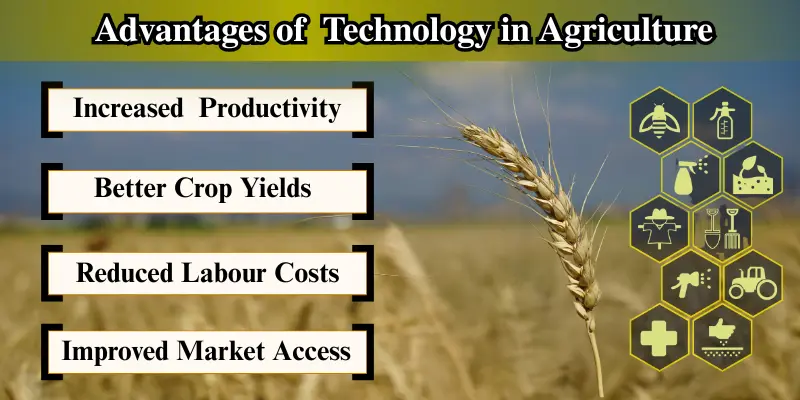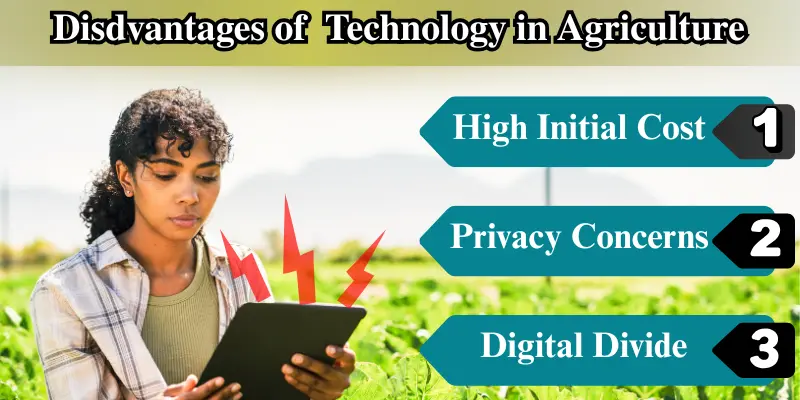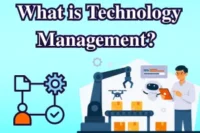Advantages and Disadvantages of Technology in Agriculture
Published: 19/Sep/2025
Technology has always played an important role in shaping industries, and agriculture is no different. Over the years, new technologies have transformed farming, making it more efficient, sustainable, and productive. From drones flying over fields to machines automatically planting and harvesting crops, the way we farm is evolving rapidly. But with these advancements also come challenges.
In this article, we’ll explore both the advantages and disadvantages of technology in agriculture, and see how it is changing farming and what problems may arise along the way. So, let’s dive in
Advantages of Technology in Agriculture
Technology helps farmers in different ways. Modern tools and machines offer many benefits, making farming easier and more productive.

Here are some key advantages:
- Increased Efficiency and Productivity
- Better Crop Yields
- Sustainability and Resource Conservation
- Reduced Labour Costs
- Data-Driven Decision Making
- Improved Insect and Disease Management
- Improved Market Access
- Innovative Farming Practices
Let’s explore these advantages in detail and see how technology is reshaping the future of farming.
1. Increased Efficiency and Productivity
One of the primary benefits of technology in agriculture is the dramatic increase in productivity. Automated machinery, drones, and smart irrigation systems help reduce manual labour, speed up processes, and minimize errors. Tasks that used to take days can now be completed in hours. For example, GPS-guided tractors can plant seeds with pinpoint accuracy, ensuring better seed placement and reducing waste.
This increased efficiency allows farmers to manage larger plots of land with fewer resources, resulting in higher output and profitability. It also reduces the time needed for day-to-day farming activities, allowing farmers to focus on other important aspects of the business.
2. Better Crop Yields
Advancements in technology, particularly in precision farming, have greatly enhanced crop yields. Using data from soil sensors, weather forecasting, and satellite imagery, farmers can monitor the health of their crops in real-time. This information helps them determine the best times for planting, watering, and harvesting.
For example, IoT (Internet of Things) sensors can monitor soil moisture and temperature, allowing farmers to water crops only when needed, reducing water usage and ensuring plants receive exactly what they need. As a result, these technologies produce healthier crops with higher yields.
3. Sustainability and Resource Conservation
With the global population steadily increasing, sustainable farming practices are becoming more essential than ever. Technology is key to reducing agriculture’s environmental impact. Advanced farming tools not only help farmers optimize water usage and fertilizers but also minimize pesticide application by targeting only areas that need attention.
For example, drones with infrared sensors can identify areas affected by pests or diseases. This allows farmers to treat only the problem areas instead of spraying the entire field. As a result, less chemical is used, which helps protect the environment and promotes a more sustainable future for farming.
4. Reduced Labour Costs
Another key advantage of technology is its ability to reduce labour costs. With automation in planting, harvesting, and monitoring, farmers can manage more land with fewer workers. This is particularly beneficial for small and medium-scale farms where labour costs can eat into profits.
Take automated harvesters, for example. These machines can work 24/7, making the harvest process faster and more efficient. They also reduce the need for manual labour, which can be costly and hard to find, especially during peak harvest seasons.
You May Also Like This Post
➡️ Types of Digital Technology: Examples, Applications, & Benefits
5. Data-Driven Decision Making
Big data and analytics have transformed agriculture into a data-driven industry. Farmers can now make informed decisions based on a wealth of data, including weather patterns, soil health, crop conditions, and market trends. This data-driven approach leads to more accurate planning and better decision-making.
For example, farmers can use farm management software to track their yields, plan crop rotations, and predict market prices, helping them make smarter decisions about their investments and operations.
6. Improved Insect and Disease Management
Technology has made insect and disease management more precise and effective. With the help of AI-powered monitoring systems and smart sensors, farmers can detect problems early, before they become serious issues. By using machine learning algorithms, farmers can predict insect outbreaks and prevent diseases from spreading, minimizing the need for excessive pesticide use.
7. Improved Market Access
With the rise of e-commerce and digital platforms, technology has allowed farmers to reach a global market. Platforms like Agri-tech marketplaces allow farmers to sell their products directly to consumers or buyers worldwide. This not only boosts the farmer’s profit margins by cutting out middlemen but also gives them access to broader markets that were once out of reach.
For example, a small farmer growing organic vegetables can now sell them directly to consumers through an online marketplace, increasing their income and creating a more sustainable business model.
8. Innovative Farming Practices
New technologies are also making it possible to adopt more advanced farming practices, such as vertical farming and aquaponics. These methods use technology to grow food in more controlled environments, often in urban areas, reducing the need for traditional land-based farming. This opens up opportunities for urban agriculture and food security, making agriculture more sustainable and efficient.
Disadvantages of Technology in Agriculture
While technology brings many benefits to farming, it also presents several challenges.

Here are some main disadvantages:
- High Initial Investment Costs
- Dependency on Technology
- Job Displacement in Rural Areas
- Digital Divide and Access Issues
- Training and Knowledge Gaps
- Data Privacy and Security Concerns
- Environmental Impact of E-Waste
- Overuse of Resources
Let’s explore these drawbacks in detail and understand the potential challenges technology presents in agriculture.
1. High Initial Investment
While technology can improve farming efficiency but the start-up investment can be expensive, especially for small-scale or new farmers. The cost of purchasing high-tech equipment, like drones, automated tractors, and sensors, can be overwhelming. Additionally, ongoing maintenance and training costs add to the financial burden.
2. Dependency on Technology
Over-reliance on technology can create problems. If the technology fails, whether due to a technical glitch or power outage, farming operations can be disrupted. Without proper backup systems, farmers may struggle to get back on track, causing delays and financial losses.
3. Job Losses in Rural Areas
The increased use of machines and advanced technology in agriculture is reducing the need for manual labour. As a result, many workers in rural areas face job losses, leading to unemployment and economic instability in those communities. This shift not only affects workers’ livelihoods but can also disrupt the local economy, especially in regions where farming is a primary source of income.
4. Digital Divide
Not all farmers have access to the same level of technology. In many rural areas, internet connectivity is still unreliable, and farmers may not have the necessary resources or skills to adopt the latest technologies. This digital divide can further extend the gap between small and large-scale farms.
5. Training and Knowledge Gaps
The adoption of advanced technologies requires farmers to have a certain level of technical knowledge. Many farmers, especially older generations, may not be comfortable using or maintaining high-tech equipment. Training programs are needed, but the resources for such education are not always accessible.
6. Data Privacy Concerns
As technology use in agriculture increases, concerns about data privacy and security grow. Sensitive farm data, like crop yields, market prices, and resource usage, could be at risk if not properly protected. Farmers must ensure their data is secure and follow proper data protection regulations.
7. Environmental Impact of E-Waste
As more technology is used in farming, the amount of electronic waste (e-waste) also increases. The disposal of outdated or broken equipment can contribute to environmental pollution if not properly managed.
8. Overuse of Resources
Despite the benefits of accurate farming, there’s still a risk that technology may lead to overuse of certain resources, such as water or chemicals, if not managed properly.
For example, if sensors or automated systems are not calibrated correctly, they might lead to excessive irrigation or pesticide use, harming both crops and the environment.
Conclusion
Technology in agriculture is a double-edged sword. On one hand, it offers farmers powerful tools to increase efficiency, boost crop yields, and make farming more sustainable. On the other hand, it brings challenges like high costs, job losses, and data privacy risks.
The key is finding balance—adopting technology carefully while ensuring farmers have access to the right training, support, and resources. With proper planning, technology can help agriculture feed a growing population, protect the environment, and secure a better future for farmers and communities worldwide.
Frequently Asked Questions
Below are answers to some common questions about the pros and cons of technology in agriculture:
The five main advantages of technology in agriculture include:
- Increased Efficiency and Productivity
- Better Crop Yields
- Sustainability and Resource Conservation
- Reduced Labour Costs
- Improved Decision Making with Data
The five main disadvantages of technology in agriculture include:
- High Initial Investment
- Dependency on Technology
- Job Losses in Rural Areas
- Digital Divide
- Data Privacy and Security Concerns
The future of agriculture will see even more advanced technologies, such as AI-powered systems, robotic farming tools, and gene editing. These innovations will help farmers meet the growing demand for food, increase efficiency, and make farming practices more sustainable. As technology advances, it will play an even larger role in reshaping how food is produced globally.
Modern technology improves crop yields through precision farming, where farmers use data from sensors, drones, and satellite imagery to monitor crop health. This allows for more accurate planting, watering, and harvesting. As a result, crops grow healthier and more efficiently, leading to higher yields.
Agricultural technology helps farmers improve their productivity by automating tasks, managing resources better, and making informed decisions. It allows them to grow more crops with fewer resources and reduce costs. However, it can also create challenges, like the need for training and the risk of job displacement in rural areas.





